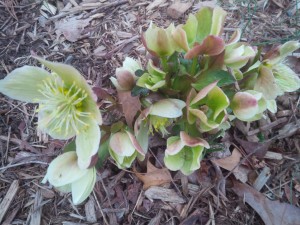
At this time of year, all it takes is a few balmy days to trigger the gardening itch. As soon as the temperature hovers above 50 degrees and the wind abandons howling in favor of murmuring, I have one foot out the door.
I am fooling myself, of course. February thaws are among of Nature’s greatest teases and usually give way to renewed Arctic blasts, “wintery mix” onslaughts and successions of gray days.
My garden—front and back—is a scene of horticultural carnage, strewn with dead leaves, broken branches, desiccated stalks and other souvenirs of wintery weather and neglected clean-up. The overgrown shrubs look haggard, with no greenery to soften harsh lines or hide long dead flowerheads. Evergreen hollies and euonymus cling faithfully to their green leaves, providing shelter for the birds and a reminder that life goes on, even when the temperature goes down. Unfazed by even the worst weather, stalwart agave sports long fibrous leaves that defy the elements.
As I search around for the misplaced mate of my best garden glove and attempt to locate the sharpening tool for my Felco pruners, I remind myself of the physicians’ and gardeners’ credo: “Above all, do no harm.” Just because a late winter thaw has taken hold, doesn’t mean that you should start an entire spring clean-up. Instead, take care of chores that will make you feel productive now and help the plants later on.
If you applied winter mulch in the late fall, keep it in place until the last frost date passes for your area. If you don’t know your last frost date, find it online at https://davesgarden.com/guides/freeze-frost-dates/. Printed guides, like the time-honored Old Farmer’s Almanac, are also likely to carry this information. Mulches are insulating blankets for the soil, protecting the slumbering plants from sudden freezes and thaws. Don’t remove them until spring has truly sprung. The same goes for winter wrappings on plants like roses and fig trees that you may have swathed for protection against the cold.
If you neglected to mulch, but allowed “lazy man’s mulch”, otherwise known as dead leaves, accumulate in the beds and borders, follow the same rule as for more expensive mulch. Insulation is insulation, even if it isn’t glamorous.
If time is short, pick up sticks, branches and debris from your lawn and garden. Of course there will be more of the same in four week’s time, but at least you have given yourself a head start. If the yard is not too muddy, you can also gently rake or blow away the dead leaves lingering on the grass.
Many of us have hydrangeas and many of those hydrangeas are still burdened with the sad remnants of the flowers that bloomed so abundantly last summer. If you are in the pruning frame of mind, nip off only the dead flowerheads. To indulge in further pruning at this early stage might result in the loss of buds that will produce next summer’s hydrangea blooms. If your garden is home to other spring-blooming shrubs, keep your pruning urges in check until after they flower later on. Hold off on rose pruning until at least St. Patrick’s Day, depending on when early spring starts in your part of the world.
All dead stalks of perennials and annuals are fair game now and a whacking session can make the garden look infinitely better. If you left the flower stalks on plants like echinacea or coreopsis to supply fall and early winter seeds to the birds, pat yourself on the back. The seed heads have served their purpose and are ready to be lopped off and sent to the compost pile.
Though it isn’t time to removed mulches, it is time to clear away mulch, leaves or debris from the areas closest to early risers like snowdrops, winter aconite and hellebores. Be gentle about this, because the goal is to give the small plants a little elbow room and make it easier for garden visitors to see them. You can even dispense with tools and simply clear the spaces by moving the leaves aside with your hands.
Of course, you can always do what the garden mavens recommend and spend these late winter days cleaning your tools and whittling down your catalog and internet orders to something that you can almost afford. I recommend waiting until the sleet resumes for that. When it’s balmy, get outside.

